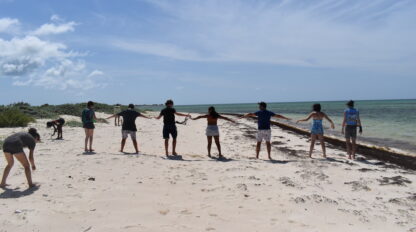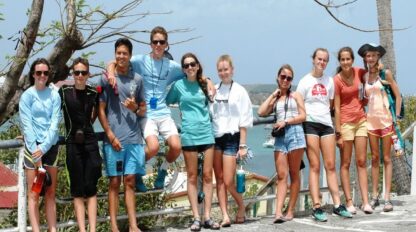Scuba Safari – Part 2
 I’m so glad you got my attention – out of the crevice to which you pointed swam a Green Moray Eel! Eels are primarily nocturnal, so it’s pretty rare and exciting to see one in the daylight. They have very poor eyesight and rely heavily on their sense of smell to hunt. These slimy-skinned fish have a bad rep for looking mean and angry. Really, they just have primitive respiratory systems and must continuously pump water over their gills. In fact, eels are very shy (even the 5 foot long ones!) unless they smell food or if something invades its den. They do have a nasty bite though (razor-sharp teeth pointing backwards), so I wouldn’t recommend sticking your hand into any dark cracks!
I’m so glad you got my attention – out of the crevice to which you pointed swam a Green Moray Eel! Eels are primarily nocturnal, so it’s pretty rare and exciting to see one in the daylight. They have very poor eyesight and rely heavily on their sense of smell to hunt. These slimy-skinned fish have a bad rep for looking mean and angry. Really, they just have primitive respiratory systems and must continuously pump water over their gills. In fact, eels are very shy (even the 5 foot long ones!) unless they smell food or if something invades its den. They do have a nasty bite though (razor-sharp teeth pointing backwards), so I wouldn’t recommend sticking your hand into any dark cracks!
 We follow the free-swimming moray around the corner and watch it disappear under a rock ledge. As we peek underneath the ledge we see a dark brown caudal (tail) fin lying in the sand! A large nurse shark is taking her afternoon nap, resting up for the evenings hunting activities. Nurse sharks are solitary hunters, mostly eating crustaceans and mollusks which they find on the ocean floor. They often rest in large groups (sometimes 40 sharks in the same place!) and have preferred resting areas – so most likely if we came back here tomorrow, she’d be here again!
We follow the free-swimming moray around the corner and watch it disappear under a rock ledge. As we peek underneath the ledge we see a dark brown caudal (tail) fin lying in the sand! A large nurse shark is taking her afternoon nap, resting up for the evenings hunting activities. Nurse sharks are solitary hunters, mostly eating crustaceans and mollusks which they find on the ocean floor. They often rest in large groups (sometimes 40 sharks in the same place!) and have preferred resting areas – so most likely if we came back here tomorrow, she’d be here again!

As a cloud passes over the bright Caribbean sun, the underwater world becomes dim and a school of shiny red Squirrel Fish tentatively venture out from another overhang nearby. Their giant black eyes stare at us – curious but nervous. As soon as the sun shines back through the clouds and the squirrelly fish realize that it’s not yet dusk, they retreat to the dim recesses beneath the ledge.
 We check our gauges and realize that soon we must surface, so we begin retracing our kicks. Right away we notice a young Hawksbill Sea Turtle grazing on sponges growing on the reef – an easy way to determine the type of turtle since the Green Sea Turtle eats only seagrass. He moves on to a less crowded feeding area once he notices us – maybe he’s worried that we might be working on an environmental service project.
We check our gauges and realize that soon we must surface, so we begin retracing our kicks. Right away we notice a young Hawksbill Sea Turtle grazing on sponges growing on the reef – an easy way to determine the type of turtle since the Green Sea Turtle eats only seagrass. He moves on to a less crowded feeding area once he notices us – maybe he’s worried that we might be working on an environmental service project.
 The anchor chain which we will use to ascend back to the surface is now in sight, and as we swim toward it, a new buddy appears to want to join our group. A shiny Barracuda sidles up next to us and watches us out of the corner of his eye. Barracuda are big, fast fish with lots of sharp teeth, but there’s no need to be afraid. They are super curious and like shiny things so they tend to follow divers around, but they prefer to snack on small fish and will give you plenty of warning signs if you approach too closely.
The anchor chain which we will use to ascend back to the surface is now in sight, and as we swim toward it, a new buddy appears to want to join our group. A shiny Barracuda sidles up next to us and watches us out of the corner of his eye. Barracuda are big, fast fish with lots of sharp teeth, but there’s no need to be afraid. They are super curious and like shiny things so they tend to follow divers around, but they prefer to snack on small fish and will give you plenty of warning signs if you approach too closely.
 What an amazing dive we had! And to top it all off, right at the base of the anchor chain is a very rare sight indeed! A Long Snout Seahorse has curled its prehensile tail around a bit of coral. Pretending that we cannot see it, the seahorse tucks its snout and turns its head hoping that we leave it alone. We snap our photo and begin our ascent.
What an amazing dive we had! And to top it all off, right at the base of the anchor chain is a very rare sight indeed! A Long Snout Seahorse has curled its prehensile tail around a bit of coral. Pretending that we cannot see it, the seahorse tucks its snout and turns its head hoping that we leave it alone. We snap our photo and begin our ascent.
I couldn’t have asked for a better dive buddy – you must be a good luck charm because we saw so much incredible marine life! (If you missed the first part, Click Here!) The best part is we didn’t even come close to seeing it all – I can’t wait to get back in the water!
What favorite sea creatures have you seen (or hope to see!) on a dive or snorkel?

